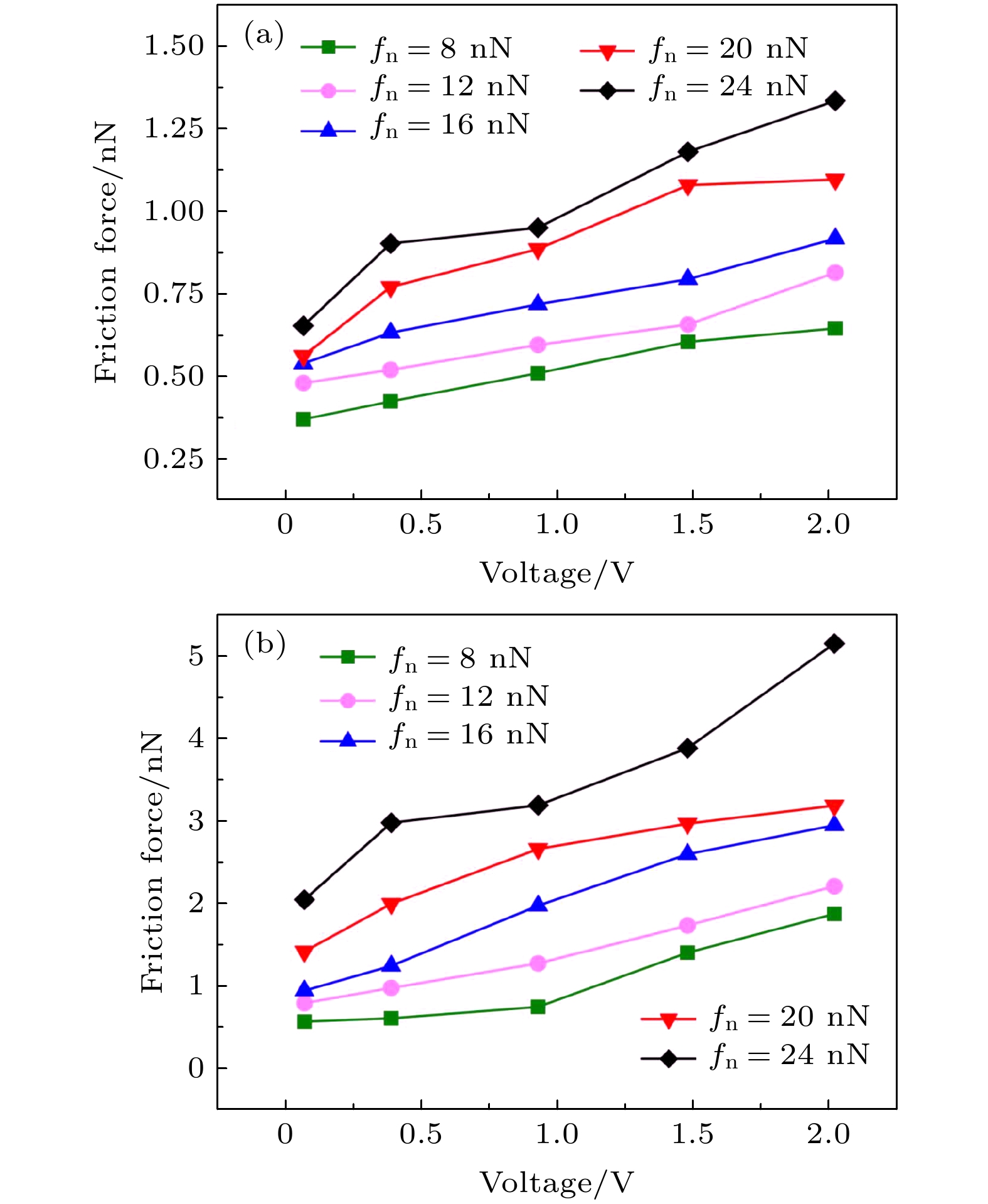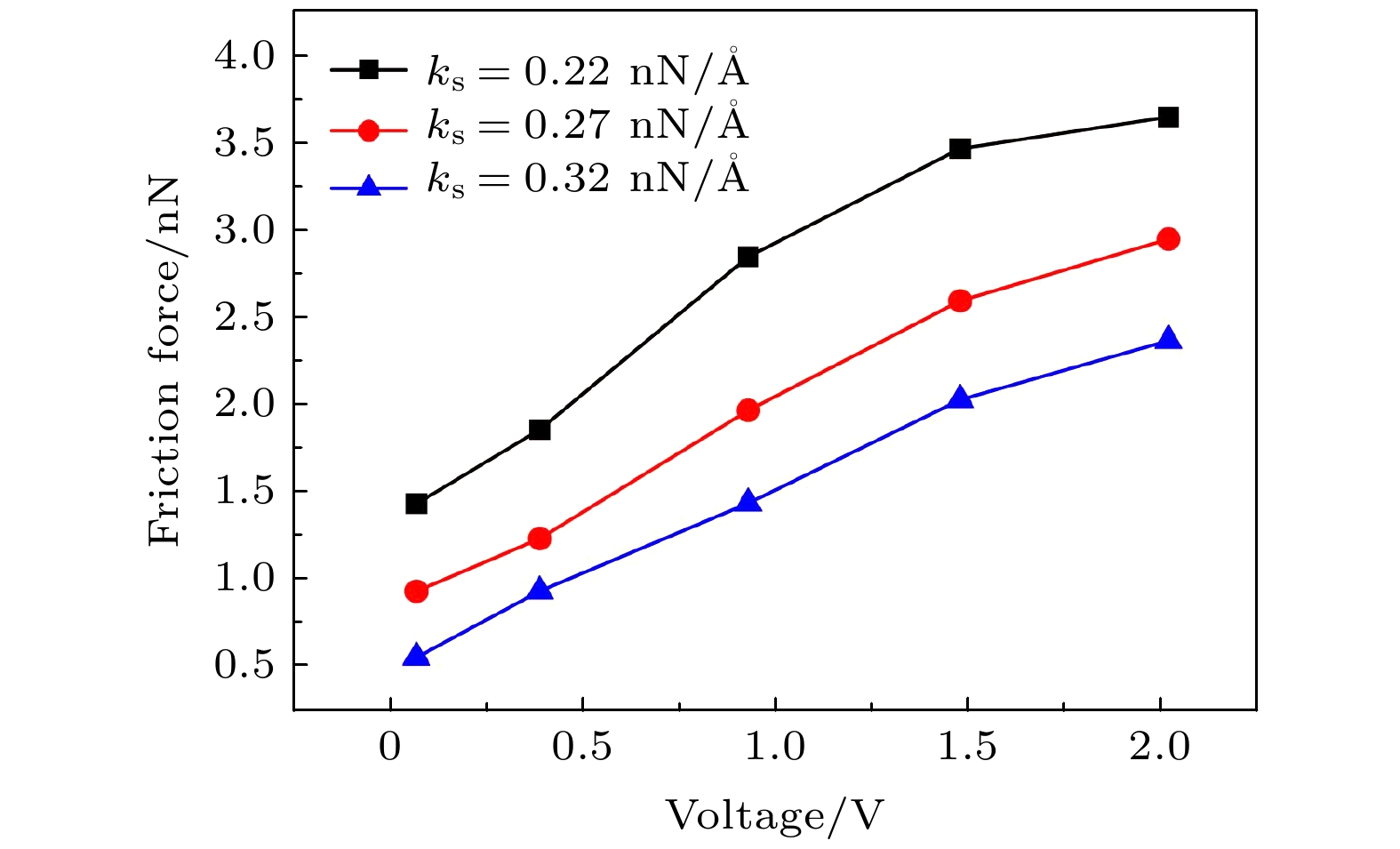-
采用分子动力学方法建立单晶硅针尖与石墨烯相对滑移的分子模型, 研究界面电流对石墨烯摩擦性能的影响. 研究结果表明: 当施加偏压时, 针尖所受的摩擦力比无偏压时增大一个数量级; 载流摩擦力随偏压的增大而增大, 但不同偏压方向的增幅速率却不一致; 不同的法向载荷和基底支撑刚度下石墨烯均呈现出较为稳定的载流摩擦行为, 其相似的摩擦力-电压关系验证了载流影响的稳定性. 电流引入后摩擦力的上升可归因于载流区域的扩大, 导致库伦相互作用在摩擦界面处的吸附能中占据主要地位. 基于Prandtl-Tomlinson模型系统讨论了石墨烯的载流摩擦机理, 认为该机理与石墨烯的褶皱效应相违背, 而遵循能量势垒理论体系.Graphene has shown the great potential applications in the field of solid lubricants due to its outstanding mechanical properties and chemical inertness. The introduction of interfacial current at the graphene-lubricated surface is expected to tune the lubrication performance of graphene. Here in this work, an atomistic configuration of single-crystal silicon tip sliding against graphene supported by an elastic substrate is constructed to investigate the current-carrying friction behavior of graphene by using molecular dynamics simulations. The effects of applied voltages, normal loads and substrate stiffnesses on the current-carrying friction behavior of graphene are systematically explored. The simulation results show that when the bias voltage is applied to the graphene-based system, the friction force undertaken by the tip is one order of magnitude larger than when applying no bias voltage. The friction increases with the magnitude of bias voltage increasing, but the increasing rate varies in different directions of bias voltage. A similar friction-voltage relationship of graphene under different normal loads and substrate stiffnesses indicates its relatively stable current-carrying friction behavior and the robust current-carrying effect. The increased friction force of graphene after the introduction of interfacial current can be attributed to the expansion of current-carrying region, causing Coulomb interactions instead of van der Waals interactions to dominate the adhesions at the friction interface. Based on the Prandtl-Tomlinson model, the current-carrying friction mechanism of graphene is systematically discussed. It is found that such a friction mechanism is different from the pucker effect of graphene, but follows the energy barrier theory. This work promotes the graphene to be used as the typical solid lubricant under the complex operation conditions with the voltage-induced current going through friction interfaces.
-
Keywords:
- graphene /
- current-carrying friction /
- energy barrier /
- molecular dynamics
[1] Lee C, Wei X, Kysar J W, Hone J 2008 Science 321 385
 Google Scholar
Google Scholar
[2] Li S, Li Q, Carpick R W, Gumbsch P, Liu X, Ding X, Sun J, Li J 2016 Nature 539 541
 Google Scholar
Google Scholar
[3] Lee C, Li Q, Kalb W, Liu X, Berger H, Carpick R W, Hone J 2010 Science 328 76
 Google Scholar
Google Scholar
[4] Filleter T, McChesney J L, Bostwick A, et al. 2009 Phys. Rev. Lett. 102 1
 Google Scholar
Google Scholar
[5] Ding T, Chen G, Li Y, Yang H, He Q 2014 Tribol. Int. 79 8
 Google Scholar
Google Scholar
[6] Yasar I, Canakci A, Arslan F 2007 Tribol. Int. 40 1381
 Google Scholar
Google Scholar
[7] 沈向前, 孙乐民, 张永振 2006 润滑与密封 1 72
 Google Scholar
Google Scholar
Shen X, Sun L, Zhang Y 2006 Lubr. Eng. 1 72
 Google Scholar
Google Scholar
[8] 王一帆 2015 硕士毕业论文 (洛阳: 河南科技大学)
Wang Y 2015 M. S. Thesis (Luoyang: Henan University of Science and Technology) (in Chinese)
[9] 谢博华, 鞠鹏飞, 吉利, 李红轩, 周惠娣, 陈建敏 2019 摩擦学学报 39 656
 Google Scholar
Google Scholar
Xie B, Ju P, Ji L, Li H, Zhou H, Chen J 2019 Tribology 39 656
 Google Scholar
Google Scholar
[10] Jiang Y, Li Y, Liang B, Yang X, Han T, Wang Z 2012 Nanotechnology 23 495703
 Google Scholar
Google Scholar
[11] Berman D, Erdemir A, Sumant A V 2014 Appl. Phys. Lett. 105 231907
 Google Scholar
Google Scholar
[12] Lee J, Hu X, Voevodin A, Martini A, Berman D 2018 Micromachines 9 1
 Google Scholar
Google Scholar
[13] Chang T, Zhang H, Guo Z, Guo Z, Gao H 2015 Phys. Rev. Lett. 114 1
 Google Scholar
Google Scholar
[14] Peng Y, Li J, Tang X, Liu B, Chen X, Bai L 2020 Tribol. Lett. 68 1
 Google Scholar
Google Scholar
[15] Plimpton S 1995 J. Comput. Phys. 117 1
 Google Scholar
Google Scholar
[16] Stukowski A 2010 Modell. Simul. Mater. Sci. Eng. 18 015012
 Google Scholar
Google Scholar
[17] Srinivasan S G, Duin A C, Ganesh P 2015 J. Phys. Chem. A. 119 571
 Google Scholar
Google Scholar
[18] Liu J, Qi Y, Li Q, Duan T, Yue W, Vadakkepatt A, Ye C, Dong Y 2019 Carbon 142 363
 Google Scholar
Google Scholar
[19] Lang H, Peng Y, Cao X, Zou K 2020 ACS Appl. Mater. Interfaces 12 25503
 Google Scholar
Google Scholar
[20] Deng Z, Smolyanitsky A, Li Q, Feng X, Cannara R J 2012 Nat. Mater. 11 1032
 Google Scholar
Google Scholar
[21] Deng Z, Klimov N N, Solares S D, Li T, Xu H, Cannara R J 2013 Langmuir 29 235
 Google Scholar
Google Scholar
[22] Bagheri S, Mansouri N, Aghaie E 2016 Int. J. Hydrogen Energy. 41 4085
 Google Scholar
Google Scholar
[23] Zhang H, Guo Z, Gao H, Chang T 2015 Carbon 94 60
 Google Scholar
Google Scholar
[24] Li J, Peng Y, Tang X, Tang X, Xu Q, Liu B, Bai L 2021 Tribol. Lett. 69 1
 Google Scholar
Google Scholar
[25] Sun K, Fan X, Zhang W, Xue P, Diao D 2019 Carbon 149 45
 Google Scholar
Google Scholar
[26] 董霖, 陈光雄, 周仲荣 2009 润滑与密封 34 102
 Google Scholar
Google Scholar
Dong L, Chen G, Zhou Z 2009 Lubr. Eng. 34 102
 Google Scholar
Google Scholar
[27] Liu F, Hu N, Ning H, Liu Y, Li Y, Wu L 2015 Comput. Mater. Sci. 108 160
 Google Scholar
Google Scholar
[28] Tomlinson G A 1929 Philos. Mag. 7 905
 Google Scholar
Google Scholar
[29] Li J, Peng Y, Tang X, Xu Q, Bai L 2021 Phys. Chem. Chem. Phys. 23 4988
 Google Scholar
Google Scholar
[30] Matsuda K, Hashimoto D, Nakamura K 2016 Tribol. Int. 93 523
 Google Scholar
Google Scholar
[31] Mandelli D, Leven I, Hod O, Urbakh M 2017 Sci. Rep. 7 1
 Google Scholar
Google Scholar
-
表 1 石墨烯的接触和载流半径
Table 1. Contact and current-carrying radius of graphene
正偏压 负偏压 无偏压 接触半径/Å 12.0 11.5 10.2 载流半径/Å 8.4 9.6 — -
[1] Lee C, Wei X, Kysar J W, Hone J 2008 Science 321 385
 Google Scholar
Google Scholar
[2] Li S, Li Q, Carpick R W, Gumbsch P, Liu X, Ding X, Sun J, Li J 2016 Nature 539 541
 Google Scholar
Google Scholar
[3] Lee C, Li Q, Kalb W, Liu X, Berger H, Carpick R W, Hone J 2010 Science 328 76
 Google Scholar
Google Scholar
[4] Filleter T, McChesney J L, Bostwick A, et al. 2009 Phys. Rev. Lett. 102 1
 Google Scholar
Google Scholar
[5] Ding T, Chen G, Li Y, Yang H, He Q 2014 Tribol. Int. 79 8
 Google Scholar
Google Scholar
[6] Yasar I, Canakci A, Arslan F 2007 Tribol. Int. 40 1381
 Google Scholar
Google Scholar
[7] 沈向前, 孙乐民, 张永振 2006 润滑与密封 1 72
 Google Scholar
Google Scholar
Shen X, Sun L, Zhang Y 2006 Lubr. Eng. 1 72
 Google Scholar
Google Scholar
[8] 王一帆 2015 硕士毕业论文 (洛阳: 河南科技大学)
Wang Y 2015 M. S. Thesis (Luoyang: Henan University of Science and Technology) (in Chinese)
[9] 谢博华, 鞠鹏飞, 吉利, 李红轩, 周惠娣, 陈建敏 2019 摩擦学学报 39 656
 Google Scholar
Google Scholar
Xie B, Ju P, Ji L, Li H, Zhou H, Chen J 2019 Tribology 39 656
 Google Scholar
Google Scholar
[10] Jiang Y, Li Y, Liang B, Yang X, Han T, Wang Z 2012 Nanotechnology 23 495703
 Google Scholar
Google Scholar
[11] Berman D, Erdemir A, Sumant A V 2014 Appl. Phys. Lett. 105 231907
 Google Scholar
Google Scholar
[12] Lee J, Hu X, Voevodin A, Martini A, Berman D 2018 Micromachines 9 1
 Google Scholar
Google Scholar
[13] Chang T, Zhang H, Guo Z, Guo Z, Gao H 2015 Phys. Rev. Lett. 114 1
 Google Scholar
Google Scholar
[14] Peng Y, Li J, Tang X, Liu B, Chen X, Bai L 2020 Tribol. Lett. 68 1
 Google Scholar
Google Scholar
[15] Plimpton S 1995 J. Comput. Phys. 117 1
 Google Scholar
Google Scholar
[16] Stukowski A 2010 Modell. Simul. Mater. Sci. Eng. 18 015012
 Google Scholar
Google Scholar
[17] Srinivasan S G, Duin A C, Ganesh P 2015 J. Phys. Chem. A. 119 571
 Google Scholar
Google Scholar
[18] Liu J, Qi Y, Li Q, Duan T, Yue W, Vadakkepatt A, Ye C, Dong Y 2019 Carbon 142 363
 Google Scholar
Google Scholar
[19] Lang H, Peng Y, Cao X, Zou K 2020 ACS Appl. Mater. Interfaces 12 25503
 Google Scholar
Google Scholar
[20] Deng Z, Smolyanitsky A, Li Q, Feng X, Cannara R J 2012 Nat. Mater. 11 1032
 Google Scholar
Google Scholar
[21] Deng Z, Klimov N N, Solares S D, Li T, Xu H, Cannara R J 2013 Langmuir 29 235
 Google Scholar
Google Scholar
[22] Bagheri S, Mansouri N, Aghaie E 2016 Int. J. Hydrogen Energy. 41 4085
 Google Scholar
Google Scholar
[23] Zhang H, Guo Z, Gao H, Chang T 2015 Carbon 94 60
 Google Scholar
Google Scholar
[24] Li J, Peng Y, Tang X, Tang X, Xu Q, Liu B, Bai L 2021 Tribol. Lett. 69 1
 Google Scholar
Google Scholar
[25] Sun K, Fan X, Zhang W, Xue P, Diao D 2019 Carbon 149 45
 Google Scholar
Google Scholar
[26] 董霖, 陈光雄, 周仲荣 2009 润滑与密封 34 102
 Google Scholar
Google Scholar
Dong L, Chen G, Zhou Z 2009 Lubr. Eng. 34 102
 Google Scholar
Google Scholar
[27] Liu F, Hu N, Ning H, Liu Y, Li Y, Wu L 2015 Comput. Mater. Sci. 108 160
 Google Scholar
Google Scholar
[28] Tomlinson G A 1929 Philos. Mag. 7 905
 Google Scholar
Google Scholar
[29] Li J, Peng Y, Tang X, Xu Q, Bai L 2021 Phys. Chem. Chem. Phys. 23 4988
 Google Scholar
Google Scholar
[30] Matsuda K, Hashimoto D, Nakamura K 2016 Tribol. Int. 93 523
 Google Scholar
Google Scholar
[31] Mandelli D, Leven I, Hod O, Urbakh M 2017 Sci. Rep. 7 1
 Google Scholar
Google Scholar
计量
- 文章访问数: 6126
- PDF下载量: 129
- 被引次数: 0














 下载:
下载:







